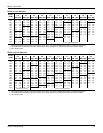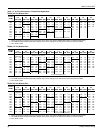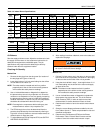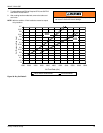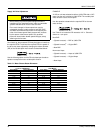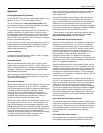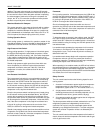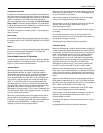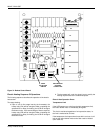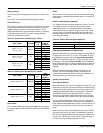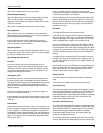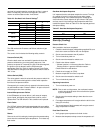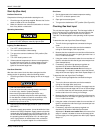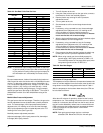
292447-YIM-A-0507
Unitary Products Group 45
addition. The power exhaust motor is energized 45 seconds
after the actuator position exceeds the exhaust fan set point on
the economizer control. When the power exhaust is operating,
the second stage of mechanical cooling will not operate. As
always, the "R" to "G" connection provides minimum position
but does not provide power exhaust operation.
Motorized Outdoor Air Dampers
This system operation is the same as the units with no outdoor
air options with one exception. When the "R" to "G" circuit is
complete, the motorized damper drives open to a position set
by the thumbwheel on the damper motor. When the "R" to "G"
circuit is opened, the damper spring returns fully closed.
Cooling Operation Errors
Each cooling system is monitored for operation outside of the
intended parameters. Errors are handled as described below. All
system errors override minimum run times for compressors.
High-Pressure Limit Switch
During cooling operation, if a high-pressure limit switch opens,
the UCB will de-energize the associated compressor, initiate
the ASCD (Anti-short cycle delay), and, if the other compressor
is idle, stop the condenser fans. If the call for cooling is still
present at the conclusion of the ASCD, the UCB will re-energize
the halted compressor.
Should a high-pressure switch open three times within two
hours of operation, the UCB will lock-out the associated
compressor and flash a code (see Table 30). If the other
compressor is inactive, the condenser fans will be de-
energized.
Low-Pressure Limit Switch
The low-pressure limit switch is not monitored during the initial
30 seconds of a cooling system's operation. For the following
30 seconds, the UCB will monitor the low-pressure switch to
ensure it closes. If the low-pressure switch fails to close after
the 30-second monitoring phase, the UCB will de-energize the
associated compressor, initiate the ASCD, and, if the other
compressor is idle, stop the condenser fans.
Once the low-pressure switch has been proven (closed during
the 30-second monitor period described above), the UCB will
monitor the low-pressure limit switch for any openings. If the
low-pressure switch opens for greater than 5 seconds, the UCB
will de-energize the associated compressor, initiate the ASCD,
and, if the other compressor is idle, stop the condenser fans.
If the call for cooling is still present at the conclusion of the
ASCD, the UCB will re-energize the halted compressor.
Should a low-pressure switch open three times within one hour
of operation, the UCB will lock-out the associated compressor
and flash a code (Table 30). If the other compressor is inactive,
the condenser fans will be de-energized.
Freezestat
During cooling operation, if a freezestat opens, the UCB will de-
energize the associated compressor, initiate the ASCD, and, if
the other compressor is idle, stop the condenser fans. If the call
for cooling is still present at the conclusion of the ASCD, the
UCB will re-energize the halted compressor.
Should a freezestat open three times within two hours of
operation, the UCB will lock-out the associated compressor and
flash a code (Table 30). If the other compressor is inactive, the
condenser fans will be de-energized.
Low Ambient Cooling
To determine when to operate in low ambient mode, the UCB
has a pair of terminals connected to a temperature-activated
switch set at 45ºF. When the low ambient switch is closed and
the thermostat is calling for cooling, the UCB will operate in the
low ambient mode.
Low ambient mode operates the compressors in this manner:
10 minutes on, 5 minutes off. The indoor blower is operated
throughout the cycle. The 5-minute off period is necessary to
defrost the indoor coil.
Low ambient mode always begins with compressor operation.
Compressor minimum run time may extend the minutes of
compressor operation. The defrost cycle will begin immediately
following the elapse of the minimum run time.
When operating in low ambient mode, the UCB will not lockout
the compressors due to a freezestat trip. However, a freezestat
trip will de-energize the associated compressor. If the call for
cooling is still present at the end of the ASCD and the freezestat
has closed, the unit will resume operation.
Safety Controls
The unit control board monitors the following inputs for each
cooling system:
1. A suction line freezestat to protect against low evaporator
temperatures due to a low airflow or a low return air
temperature, (opens at 26 ± 5 °F and resets at 38 ± 5°F).
2. A high-pressure switch to protect against excessive
discharge pressures due to a blocked condenser coil or a
condenser motor failure, (opens at 625 ± 25 psig).
3. A low-pressure switch to protect against loss of refrigerant
charge, (opens at 50 ± 5 psig).
The above pressure switches are hard-soldered to the unit. The
refrigeration systems are independently monitored and
controlled. On any fault, only the associated system will be
affected by any safety/preventive action. The other refrigerant
system will continue in operation unless it is affected by the
fault as well.
The unit control board monitors the temperature limit switch of
electric heat units and the temperature limit switch and the gas
valve of gas furnace units.



